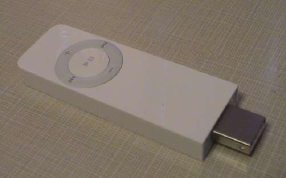
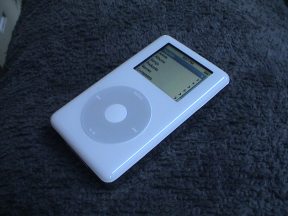
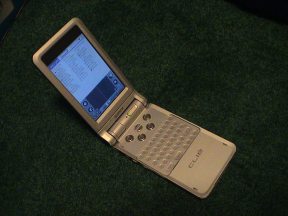
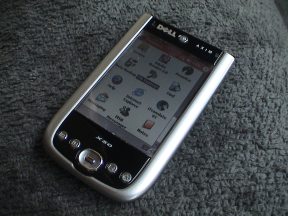
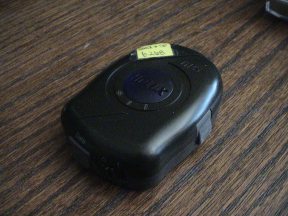
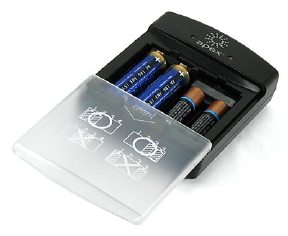
[ Previous Tip ] [ Mac Tips ] [ Next Tip ]
The Universal Serial Bus (USB) has become a popular method of connecting computer peripherals. The original USB 1.1 specification limited data rates to about 12 Mbits/sec. The updated USB 2.0 spec increases those rates to up to 480 Mbit/sec. Both versions of USB can provide DC power to peripheral devices. This power form is the subject of this page.
USB is less expensive than FireWire because a dedicated FireWire controller chip set isn't needed. The computer's CPU does the USB controller function in software. Under good conditions, USB can work nearly as well as FireWire, but at sustained high data rates, USB will sag under the strain. FireWire tends to work better but cost more therefore USB 2.0 is more common, especially in lower end hardware.
The USB 2.0 specification can be found at the link. For reference, a link to the USB 1.1 specification can be found at the bottom of the referenced page. Besides a data link, USB provides 5 +/- 0.25 volts to power an otherwise unpowered device or charge a battery in a self powered device. A USB controller or hub is required to power one unit load (100 mA, a low power load). It can optionally power up to 5 unit loads (500 mA, a high power load). The spec is silent about intermediate loads, so I assume that the sources deal with just the two cases. Either a load is low power (like a keyboard or a mouse) or high power (like an iPod or PDA).
Each USB device requires some way to power it. The device may run entirely from the USB port such as a jump drive does. Some devices have internal batteries that need charging. In any event, as the number of USB devices that I've collected has increased, management of an individual charger for each device is becoming a pain in the backside. Since the USB power form specification is a standard, ANY charger with sufficient load capability should be able to charge ANY device. In my experience, this is sometimes true and sometimes not true. iPods in particular seem to be a little picky as to what device is powering them. In a perfect world I should be able to carry only a high current charger of some convenient form factor and charge any of my USB toys with it. The question is which which charger will work with ALL of the toys.
To a first order, it is reasonable to just cut and try. I've been able to determine what loads are most sensitive and use them to test various sources. By doing that, I've mostly figured out what works with what. However, I am an engineer and as such, I want data so that I can see what is really going on. To get that data requires testing with some form of metrics available. I've elected to make a simple load tester out of an USB extension cable and a digital meter. I can test each USB power source for load handling at one and five unit loads and also measure the current draw of each USB load. Powered with this data, I can then determine which USB chargers I want to carry with me on my travels and be confident that it'll work with all of my USB devices.
The chargers come in two flavors, AC powered and DC powered. The AC powered ones typically operate from the US standard of 110 VAC but some will also deal with the worldwide range of 90-250 VAC at 50 to 60 Hz provided that a proper "gender bender" adaptor is available to allow it to plug in to international power sockets. The other type is typically in a cigarette lighter form factor and runs from +12 volts DC. There are still places where the cars are positive ground (Tahiti is one) so you must be somewhat aware with international rental cars. There is also a 12 volt standard used by some airlines, usually only in business or first class. I don't get to see those as when I fly, I am usually in coach.
I typically keep a 110 VAC inverter and a power strip in my truck so that I really only need the AC powered versions. However, the DC ones are typically small and light and can work as a backup.
I am also only concerned with USB loads that have internal rechargable batteries. Other USB powered devices (like a keyboard, jump drive or mouse) are only useful with a computer which will have USB power available anyway. USB jump drives draw little current and seem to work on any USB port.
I've got these USB powered/charged devices to play with. Most are high power loads. USB cameras, printers, and scanners typically do not draw power from USB.
| iPod shuffle |  |
| iPod photo |  |
| Sony Clie PDA |  |
| Dell Axim PDA |  |
| Holux Model GR-230XX Bluetooth GPS receiver |  |
| USB powered battery charger |  |
I've also got these USB power sources:
| The Apple 15" PowerBook has two USB 2.0 ports | 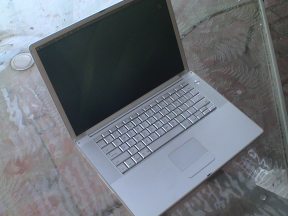 |
| The Apple iBook also has two USB 1.1 ports | 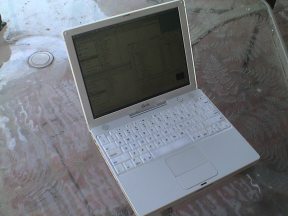 |
| The Apple Airport Express base station has a USB port that is intended to drive a printer, but it also provides power | 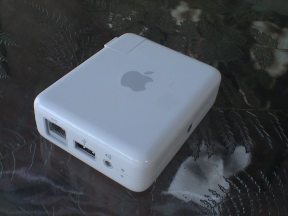 |
| The Apple USB power brick is specifically intended to charge iPods | 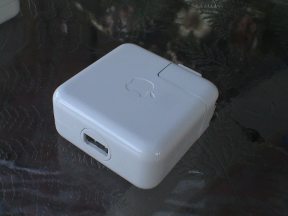 |
| Apple USB keyboard unpowered hub has two low power USB 1.1 ports | 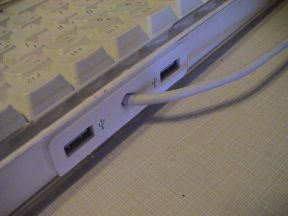 |
| This generic USB 1.1 powered hub can power 4 high power devices | 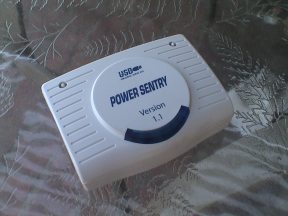
|
| This generic USB 2.0 hub can also power 4 high power devices | 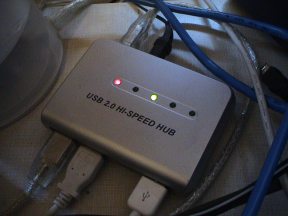 |
| This AA battery powered USB source was pretty much disappointing. It really didn't do anything that was especially interesting | 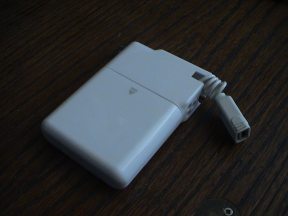 |
| Virtual Reality Sounds Lab FM transmitter/MP3 player that has a port for a USB jump drive. As an FM transmitter, it works well enough, as an MP3 play (using a jump drive for memory), it does not work very well. | 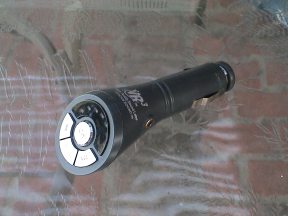 |
| This is the 12 volt USB charger that came with the Holux GPS receiver. This charger worked quite well, it can source about an amp. | 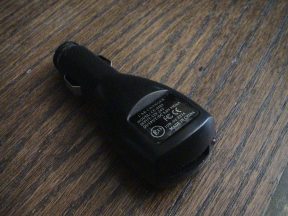 |
| The 110-240 VAC charger that came with the Holux GPS receiver is also good for about an amp. | 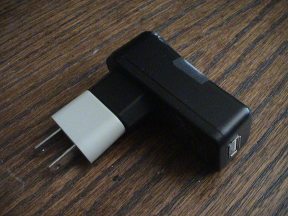 |
| This 12 volt USB charger that came with a 4-in-1 travel kit for a Sony PDA also sources about an amp. | 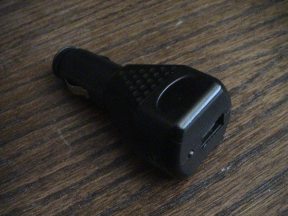
|
| The 110/250 VAC USB charger that also came in the 4-in-1 travel kit was good for about an amp. | 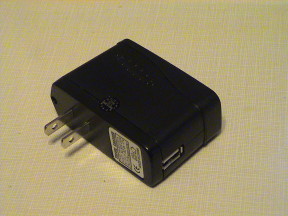 |
| The 110 VAC 100 watt inverter with a USB port (Xantrex XPower Pocket Inverter 100) is a good lightweight inverter and the USB port is quite capable. | 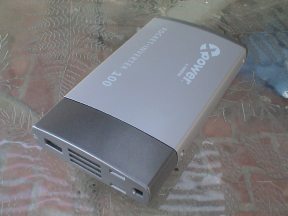 |
| The iGo Juice 70 with a Dual Port adaptor and A46 USB tip also works. The Juice can charge a computer at the same time and it will run from 110-240 volts or 12 volts. | 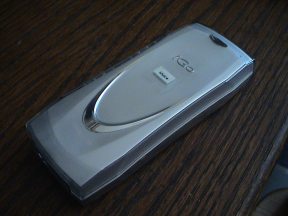 |
| The Mysoldius universal solar powered charger does indeed work in bright sun, but it can't quite source a high power load. | 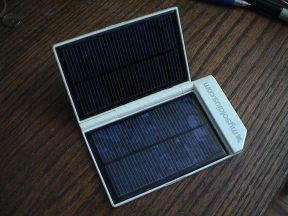 |
| The VR3 Power Inverter/FM Transmitter/USB charger seems to do everything right. It works well as an FM transmitter, it will charge anything and the inverter works pretty well too. | 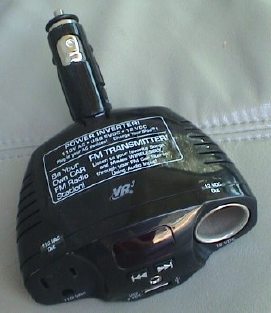 |
The object is to be able to recharge any of the USB loads with a subset of the USB chargers, one 110 VAC and one 12 VDC. The question is which ones?
The method I've selected to use to test this stuff is to load each source at 100 mA and 500 mA to see if the voltage remains in spec. I also test each load for current draw. To this end, I've built a simple test adaptor out of a USB extension cable.
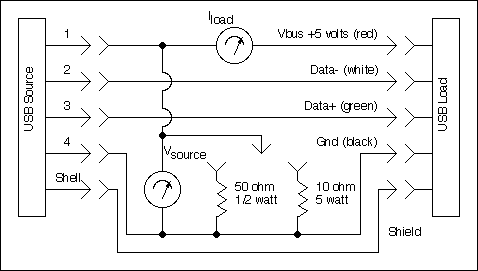 This is
the diagram of the test cable. A USB extension cable is cut and spliced
to reconnect the ground, shield and data lines. The +5 volt line is
interrupted so that a regular current meter can be inserted. Another
volt meter is used to monitor the source voltage. The two resistors act
as the test loads at 100 mA or 500 mA. A clip lead is used to connect
one resistor or the other. It is not necessary to use two different
meters as only one is needed at a time.
This is
the diagram of the test cable. A USB extension cable is cut and spliced
to reconnect the ground, shield and data lines. The +5 volt line is
interrupted so that a regular current meter can be inserted. Another
volt meter is used to monitor the source voltage. The two resistors act
as the test loads at 100 mA or 500 mA. A clip lead is used to connect
one resistor or the other. It is not necessary to use two different
meters as only one is needed at a time.
During this round of tests, the USB load is not used, neither is the current meter. The test cable is connected to the source and the voltmeter is connected as shown. Three readings are taken, one at no load (neither resistor connected) one at low load (47 to 51 ohm resistor connected) and one at high load (10 ohm resistor connected). The voltage is compared to the spec of 4.75 to 5.25 volts (4.4 to 5.25 volts for a lower power device). An out of spec voltage indicates that that particular source may not be suitable. The term OOS means Out Of Spec. Higher voltages tend to be less of a problem than low voltages, but some devices will not accept charge from an OOS high source as a means of self protection.
| Source | Voltages (volts) | In Spec? | Comments | ||||
|---|---|---|---|---|---|---|---|
| No Load | Low Load | High Load | No Load | Low Load | High Load | ||
| Virtual Reality Labs FM TX/MP3 player | 4.98 | 4.83 | 3.27 | yes | yes | OOS low | This is a low power device. This makes sense because the USB port is intended only to power a USB jump drive. However, as an FM transmitter, it works fine using an iPod as an audio source. As an MP3 player, it sucks. |
| Holux GPS RX DC adaptor | 5.40 | 5.43 | 5.37 | OOS high | OOS high | OOS high | This adaptor will probably power most USB devices, it is good for at least 850 mA because it will drive the Dell Axim. It is also efficient. It runs cool even at 850 mA. |
| Clie 4-in-1 Travel Kit DC adaptor | 5.33 | 5.31 | 5.25 | OOS high | OOS high | OOS high | The output voltage is just slightly high but it would probably work in most applications. It also powers the Dell Axim and runs cool. |
| Apple USB Power Adaptor | 5.17 | 5.15 | 5.09 | yes | yes | yes | Fully in spec. However at $29, it's a little expensive. It will not power the Dell Axim properly. |
| Clie 4-in-1 Travel Kit AC Adaptor | 5.57 | 5.54 | 5.48 | OOS high | OOS high | OOS high | This one is the highest voltage of the bunch. It does power the Dell. |
| Generic USB 2.0 Hub | 5.03 | 4.95 | 4.66 | yes | yes | OOS low | I've been using this hub to charge the iPod photo for months. Even though the voltage at high load is low, it behaves fine. |
| Generic USB 1.1 Hub | 5.11 | 5.06 | 4.89 | yes | yes | yes | in spec all around |
| Apple USB Keyboard Hub | 5.09 | 4.94 | 4.46 | yes | yes | OOS low | this is an unpowered hub within the keyboard, it is running from the USB 1.1 hub. |
| Apple 15" PowerBook | 5.02 | 4.99 | 4.86 | yes | yes | yes | |
| Apple 12" 500 MHz iBook | 5.07 | 5.03 | 4.86 | yes | yes | yes | |
| Holux GPS RX AC Adaptor | 5.38 | 5.35 | 5.28 | OOS high | OOS high | OOS high | Like its DC sibling, it also has high output voltage. It also powers the Dell Axim. |
| AA battery powered USB charger | 5.62 | 5.16 | 4.66 | OOS high | yes | OOS low | The unit had freshly charged NiMH batteries. With partially discharged batteries, the no load voltage would be in spec but the high load voltage would be even lower. |
| Airport Express Base Station | 5.02 | 4.99 | 4.88 | yes | yes | yes | |
| Xantrex XPower Pocket Inverter | 5.06 | 4.95 | 4.57 | yes | yes | OOS low | This unit also provides 110 VAC at 80 watts |
| iGo Juice 70 with USB iTip | 5.02 | 4.99 | 4.92 | yes | yes | yes | This unit also powers/charges a laptop and other devices depending on which iTip is used |
| mysoldius solar charger | 5.72 | 5.47 | 3.22 | OOS high | OOS high | OOS low | The output of the unit is somewhat dependent on the intensity of the light it receives. If the light level is too low, it goes dormant for a few seconds and charges itself up. Then it provides a short burst of power until it needs to recharge itself again. As tested in bright winter light at 7000 feet, it would not charge a high power device at all. The unit is specified at 320 mA max so it does not meet the requirements of a high powered USB load even in the most intense sun. It is not rated to charge an iPod photo. |
| VR3 Power Inverter/FM Transmitter/USB charger | 5.26 | 5.26 | 5.24 | OOS high | OOS high | yes | The USB port charges the iPod photo and shuffle fine and has the best regulation of the bunch even though the output voltage is a tad high. The inverter part doesn't like surge loads, such as incandescent bulbs. It will shut down. In that case, plug in the load and THEN plug in the inverter. |
The load current tests serve to reveal which loads will not tolerate the which sources. This could be done by cut and try as well, but as long as the test cable was handy ... well, data is good.
In this test, the voltmeter and the load resistors are not used. The test cable merely serves to allow a place to insert a current meter between the source and the load. If the current measured was less than 100 mA or 500 mA, then the load should work with a low current or high current source respectively. The source varied from test to test, but it was always an in-spec high power source so that it should not impact the current drawn by the load to any great extent.
Each load was tested in four states, running or sleeping, charged or discharged. Running the unit at full discharge should produce the highest overall load current as the source has to run the device and charge the battery at the same time.
| Source | State of Initial Charge |
Running or Sleeping |
Load Current (mA) |
Load Type (Low or High Current) |
Notes |
|---|---|---|---|---|---|
| iPod photo, backlight off | charged | running | 50 | high | The iPod consumes most of what a high power USB port can deliver |
| sleeping | 30 | ||||
| discharged | running | 430 | |||
| sleeping | 430 | ||||
| iPod photo, backlight on | charged | running | 160 | OOS high | The iPod backlight consumes another 100 mA and actually puts it a little over spec. I didn't test the peak current of the iPod while it was trying to boot with a dead battery, but I assume that it even higher yet. |
| sleeping | 160 | ||||
| discharged | running | 530 | |||
| sleeping | 530 | ||||
| iPod shuffle | charged | running | 160 | high | The shuffle doesn't draw much current, at least while charged, but it is touchy as to the quality of a USB port in the way that it's indicators respond. |
| sleeping | 150 | ||||
| discharged | running | 170 | |||
| sleeping | 160 | ||||
| Sony Clie NR70 | charged | running | 190 | high | The Clie actually draws more current while it is discharged and sleeping. Some battery manager must be at work. |
| sleeping | 50 | ||||
| discharged | running | 280 | |||
| sleeping | 320 | ||||
| Holux GPS RX | charged | running | 90 | low | This guy could work from a lower power port provided that the battery wasn't discharged. |
| sleeping | 10 | ||||
| discharged | running | 300 | |||
| sleeping | 240 | ||||
| Dell Axim X50 | charged | running | 420 | OOS high | The Axim is a good test case for USB sources. Only the best of them will drive this puppy. The current on this particular one might be a little higher than normal because it has a 4 GB microdrive in it. |
| sleeping | 130 | ||||
| discharged | running | 840 | |||
| sleeping | 620 |
The real proof is in performance. This table summarizes the response of the three loads that had some issues with one charger or another. The proper response for an iPod shuffle varies depending on conditions. If the shuffle has disk mode enabled it will mount in the Finder and will display a blinking yellow light until it is dismounted. Once dismounted (and iTunes is done with it) the light will be solid yellow until it is charged and green when charged. If the shuffle is in disk mode, the light will blink yellow until dismounted, charged or not. This is the "do not disconnect" signal.
The proper response of the iPod photo (and other iPods as well) is somewhat different. If the iPod photo has disk mode enabled, it will display a "Do Not Disconnect" message until is is dismounted. It will also display this message until iTunes is done with it. When dismounted, the display will change to the regular menu. Charging is indicated by the blinking battery icon with a lightning bolt in it. When charged, the battery icon will have a small power plug symbol in it. If the iPod is then put to sleep, the battery icon will be much larger.
The Dell Axim does not interact with a Macintosh directly. I don't know what it does on a PC. When it is trying to charge, an orange indicator above the screen will illuminate, but this doesn't mean that it is actually receiving a charge. To determine that, it is necessary to look at the Power pane in the System settings. The display will show the current state of charge and it will also indicate through a blinking status bar that the unit is actually charging. If the voltage supplying the Axim is too low, the entire display will flicker. At that point, you can be sure that it is not charging. Note that this particular Dell Axim may draw more current than most because it has a 4 GB microdrive plugged into the CF card slot.
For each of the devices below, I determined if it was really charging or not by the current that it would draw. If the device was drawing the same current that it would draw from an ideal source, it was deemed to be charging.
| Source | iPod photo | iPod shuffle | Dell Axim |
|---|---|---|---|
| 15" Powerbook | proper1 | proper | doesn't charge |
| 12" iBook | proper1 | proper | doesn't charge |
| USB 2.0 hub | proper1 | proper | doesn't charge |
| USB 1.1 hub | proper1 | proper | doesn't charge |
| Airport Express Base Station | proper charge indicator2 | Blinking yellow forever2 | doesn't charge |
| Apple USB Power Adaptor | proper | proper | Doesn't charge while the Dell is running (screen flickers) Does charge if the Dell is shut off. |
| Apple Keyboard | doesn't work3 | doesn't work3 | orange light, no charge |
| Virtual Reality Labs FM TX/MP3 player | doesn't charge | charges4 | doesn't charge |
| Holux GPS RX DC adaptor | doesn't charge | charges4 | proper |
| Holux GPS RX AC Adaptor | doesn't charge | charges4 | proper |
| Clie 4-in-1 Travel Kit AC Adaptor | doesn't charge | charges4 | proper |
| Clie 4-in-1 Travel Kit DC adaptor | doesn't charge | charges4 | proper |
| AA battery powered USB charger | doesn't charge | charges4 | flickers, doesn't charge |
| Xantrex XPower Pocket Inverter | proper1 | flashes2, 4 | flickered a little, then began to charge properly |
| iGo Juice 70 + USB iTip | doesn't charge from A46 iTip, may charge properly with B01 iTip | flashes2, 4 | doesn't charge properly with the B07 (5mm) tip and Dell supplied 5mm adaptor. The Dual Power adaptor apparently current limits at the high charging current needed by the Axim. After the Dell has accepted a partial charge from another source and the charging current has decreased a little, it WILL accept a charge from the Juice 70. The Dell does work properly with the Juice 70 and the B36 tip which was designed for the Dell. |
| mysoldius Solar Charger | not rated to charge an iPod photo | flashes2, 4 | not a chance, didn't even test it |
| VR3 Power Inverter/FM Transmitter/USB charger | proper1 | flashes2, 4 | works fine |
With older firmware, the iPod photo is completely discharged, it can try to draw more current than some in-spec USB ports can supply. It will try to to boot. When it tries to spin it's disk, then it drags the voltage too low and crashes and the cycle repeats. A very high power USB port can work, but sometimes it is necessary to initially charge the iPod from FireWire (which can supply 1.3 amps) to pick up the battery a little. Then it will charge from USB. The version 1.2.1 firmware seems to have fixed this issue. The iPod won't try to boot until the battery has picked up a bit.
Both iPods try to mount as if they were a disk but there is nothing there to respond and no way to "dismount" them except just by unplugging them. Nothing bad happens.
iPod photo causes the computer to issue a low power warning. iPod shuffle blinks a few lights, then quietly does nothing.
iPod shuffle charges but may or may not show a normal charging indication.
Most of the "dumb" chargers have sufficient current capability to charge the iPod photo but the iPod refused to accept a charge. I suspect that the iPod photo looks out on the data lines for a hint of the existence of a computer like device before it will accept a charge. The shuffle isn't so picky. It will charge as long as the USB bus is powered.
The Apple USB power adaptor is an odd ball. It fits the requirement as a "dumb" charger, but it apparently has enough smarts in it to look like a USB data source. The iPods recognize that they cannot mount on it and don't try but they will charge properly. The Airport Express Base Station also charges both iPods, but it is recognized as a real USB source and the iPods try to connect to it, hence the "do not disconnect" messages.
The mysoldius solar charger seems to deal with low power loads well enough and some loads that draw up to 230 mA. The Clie's battery was full so that it didn't draw full current, but the 230 mA that it did draw was close to the maximum rated current of the mysoldius of 320 mA. This unit comes with tips that adapt to many devices besides USB would probably be pretty handy in a pinch to charge a small PDA, shuffle, maybe an iPod nano or a cellphone.
Not all USB power sources and loads are made the same. There is clearly a pairing that produces optimal results with various devices.
The iPod shuffle is a fairly low current device (relatively anyway) and it seems to accept charge from almost any high power source. It may work with some low power sources as well as it draws only 160 mA. The charge indicator responses may be a little odd in some cases, but it seems to accept charge from many sources. Even if the lights don't make sense, another indicator of charging is that the shuffle will get a little warm around the power switch after 10 minutes or so on charge.
The iPod photo is pickier. It will accept charge ONLY from devices that will talk to it in some way. Further, these have to be high power sources as it draws nearly 500 mA. The charge indicator on the iPod photo is not ambiguous. If the thing is drawing enough current to charge, the charge indicator says so. At least there is no mystery.
The Dell will charge from anything that will put out enough current. Unfortunately, enough current is pushing twice the USB maximum current spec. You might find one that will work like the Holux chargers. However a +5 volt 1 amp wall wart with a 5 mm plug will work in the adaptor supplied by Dell with the Axim. Dell sells a charger for about $20. Hosfelt has one for $5.
While I didn't test it with all of the sources, the Clie is not picky either. At 320 mA, it will charge from any high power USB source with the cable in the 4-in-1 Travel Kit. It will also charge from a USB powered hub even if the hub isn't plugged into a computer or the computer is sleeping.
So, the answer to my original question (which one?) is answered. I will use the Apple USB adaptor exclusively. It will charge any of these toys. The Apple USB adaptor also allows an international adaptor kit to be installed on it or it can use the common gender bender outlet adaptors to allow it to connect to 240 VAC circuits. The Apple USB adaptor will charge the Dell if the Dell is shut off. For 12 volt operation, I'll just use the 110 VAC inverter that I keep in my truck all the time anyway. For traveling, I may take the Xantrex inverter because it has an adaptor that allows it to connect to some airline power outlets. However, most airlines have this capability in First or Business Class only and I usually fly coach.
We're on a cruise and the ship (Regal Princess) has only one AC outlet and the ship won't provide a way to plug more than one device in. I've got the Apple USB charger (and the firewire charger too) with me but we haven't used it yet. This is how we've worked out charging a bunch of different stuff at the same time from one AC outlet.
We've got two iBooks, two iPods, two PDA's, three cameras and the powered speakers for the iPod. Two of the cameras and the speakers run from AA rechargeable batteries. The third camera (Sony TRV-33 camcorder) is an oddball that requires it's own charger. We've also got my wife's iGo Juice70 with a selection of charging tips. We set the Juice70 to charge an iBook with an A15 tip and a B26 accessory tip to charge a Dell PDA. Then the computer distributes power to an iPod photo via firewire, a Sony PDA via USB and the iPod shuffle also via USB. Five devices charge at once from one AC outlet. To charge the AA batteries, we have to unplug this mess and use a 110 volt AA charger. To charge the Sony Camcorder we have to plug in it's own charger. I am going to try to see if I can find a iGo tip for the Sony TRV-33. Then I'll still be looking for the AA USB powered charger. With those two items, the combination of the Juice 70 and the iBook as a distribution point will allow reasonably flexible charging.
The USB battery charger is a newly added item. While traveling, I used to carry a Maha charger. This is an excellent charger, but it has it's own wall wart or 12 volt adapter so that it is a little inconvenient to carry all three pieces (the charger and 2 power cords). A USB charger would have a limited amount of power to work with and would probably take many hours to charge 4 cells at time. It would not be reasonable to recharge batteries from a computer running battery power, I assume that I would use it only when AC or 12 volt power is available and the USB power source is externally powered. The advantage is that in some hotel rooms (especially overseas) and most cruise ship staterooms, there are usually a very limited number of AC outlets, often just one. I would like to run and charge the computer from AC power (consuming the one AC outlet) and then charge the rest of the toys, including loose batteries, from the computer's USB ports. In this case, slow charging may not be a big deal because the stuff can usually charge overnight.
This particular one only draws 270 mA when charging 4 AA cells and 160 mA when charging 2 AA cells. This means that it will run from the Mysoldius solar charger in bright sunlight. It also means that high capacity rechargable batteries could take awhile to charge.
I ran a test with 4 2300 mAhr NiMH cells that were fully discharged before the test. It took 18 hours to charge all 4. Assuming 135 mA/cell, this is about right assuming a 90% charge rate efficiency. This is too long for an overnight charge so that the travel utility of this particular device is doubtful. One that would draw the full 500 mA that USB can provide would charge these cells in about 10 hours. Such a charger could work overnight.
Along with the Mac OS 10.5 (Leopard) update, Apple introduced Time Machine. This is an automatic backup system that uses some form of external disk to produce semi-real time backups of everything that changes on the system. Backups are good, so for traveling, I carry an external USB powered disk drive to allow Time Machine to do it's work. The problem is that most USB powered disk drives consume just a little more power than a spec compliant USB port can provide. Some USB ports will power these drives, some will not. My wife's iBook will power several different USB powered drives from one USB port, my PowerBook will not. It all depends on exactly how much current each USB source is capable of providing before it goes into current limiting for self protection. It appears that these external USB drives draw just a little more than the spec allows and some USB ports current limit just below that value. I was not able to actually measure the current consumption of these drives because inserting the current meter into my test cable caused just enough voltage drop to upset the drives so that they would not spin up properly even on a port that would normally power them.
There are a few ways around this problem. You can buy "two headed" USB cables designed to work around this very problem. These have two inputs, one for the USB data and power, one to add some power from a second USB port. These work with the PowerBook but they consume all the available USB ports. One can also use a powered USB hub, but there are problems there too. There is also a computer powered USB hub that combines the two-headed cable approach with a hub, but it also has issues. So far, I haven't found the "perfect" solution.
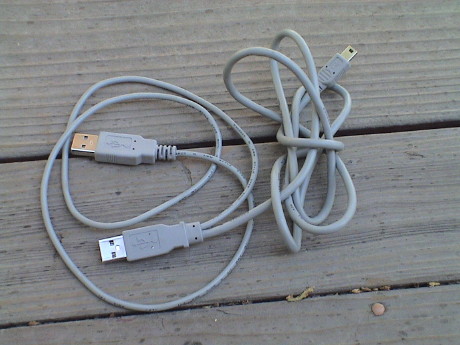 This is a two-headed USB cable that came with an Acomdata external USB drive. The
power only head (thinner wire) is long enough to reach around the
PowerBook to get to the 2nd USB port on the right side and the load end
of the cable has the small USB plug that mates with the connectors
typically found on external USB powered disk drives.
This is a two-headed USB cable that came with an Acomdata external USB drive. The
power only head (thinner wire) is long enough to reach around the
PowerBook to get to the 2nd USB port on the right side and the load end
of the cable has the small USB plug that mates with the connectors
typically found on external USB powered disk drives.
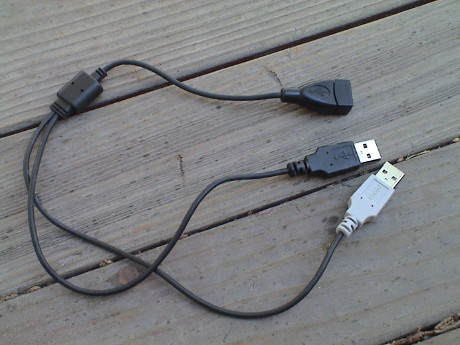 This is a more generic "Y" adaptor cable that I found
at Amazon.com. The black
plug is the usb data/power connector, the gray one is the power only
connector. This cable works well on the iBook (which has both USB ports
on the left side) but it won't reach around to the right port on the
PowerBook. I use a short standard USB extension cable to extend the
power head to use it with the PowerBook. It also has a standard USB
jack on the other end so I use the short USB cables that come with the
WD external drives to connect to the drive.
This is a more generic "Y" adaptor cable that I found
at Amazon.com. The black
plug is the usb data/power connector, the gray one is the power only
connector. This cable works well on the iBook (which has both USB ports
on the left side) but it won't reach around to the right port on the
PowerBook. I use a short standard USB extension cable to extend the
power head to use it with the PowerBook. It also has a standard USB
jack on the other end so I use the short USB cables that come with the
WD external drives to connect to the drive.
Both of these solutions work, but the issue is that the computers have only two USB ports and these cables consume both of them. Since Time Machine works best when the drive is connected all the time, this means that I cannot plug in a mouse, jump drive, or PDA cable without disconnecting the Time Machine disk.
 Some
powered USB hubs provide enough extra power on a single USB port to
power the external USB disk drives. This generic hub does provide
enough power and it works fine. The problem is that it's power adaptor
is 110 VAC only so that this particular hub is unsuitable for
travel.
Some
powered USB hubs provide enough extra power on a single USB port to
power the external USB disk drives. This generic hub does provide
enough power and it works fine. The problem is that it's power adaptor
is 110 VAC only so that this particular hub is unsuitable for
travel.
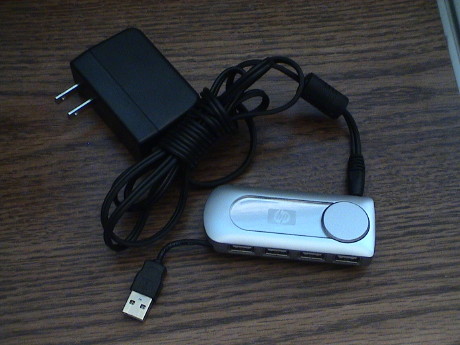 This HP travel hub is
very small and it's power adaptor is 110/220 VAC. Like the generic hub,
it has enough power available to run two external USB drives at the
same time. However, it has two problems.
This HP travel hub is
very small and it's power adaptor is 110/220 VAC. Like the generic hub,
it has enough power available to run two external USB drives at the
same time. However, it has two problems.
The power adaptor is sensitive to AC power transients. On a cruise ship, the Star Princess, every time the bathroom light was turned off, a transient in the ship's wiring would leak through the power adaptor and cause a USB wake event on the computer. If the computer was already sleeping it would try to wake, but the drive would often not spin up instantly and then the computer would complain that it could not find the drive. Eventually, when the drive did spin up, the computer would find it and move along, but the complaints from the computer were disturbing. Other wake events, such as a keyboard press or mouse click would result in a normal wake up sequence where the computer would sometimes wait for the drive in the expected fashion.
However, due to a problem with the HP hub, these wake events no matter how caused, would sometimes cause the computer to kernel panic (crash). This is bad. I suspect that this model of hub has a firmware problem because its bigger brother, a combo USB/FireWire hub that came with it, would do exactly the same thing, even on other computers. The Mac OS may indeed be overly sensitive to particular USB hubs, but still it made the hubs unusable. These hubs are no longer available from HP so they might have found that they have a problem too.
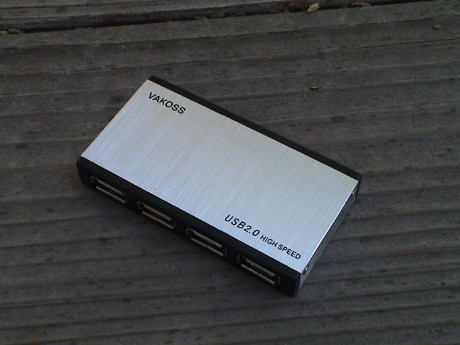 This Vakoss
TC-212-AS travel hub is only slightly larger than the HP travel hub
but it does not cause the kernel panics that the HP hubs did. However,
it is similarly sensitive to power transients. On another cruise, this
time on the Grand Princess (a sister ship to the Star Princess), the
hub reacted in the same way to the bathroom light as the HP hub, just
without the kernel panics. Further, it's power adaptor actually burned
up (buzz, crackle, pop and smoke) after a week or so at sea. I went
back to using a two-headed cable for the rest of the cruise.
This Vakoss
TC-212-AS travel hub is only slightly larger than the HP travel hub
but it does not cause the kernel panics that the HP hubs did. However,
it is similarly sensitive to power transients. On another cruise, this
time on the Grand Princess (a sister ship to the Star Princess), the
hub reacted in the same way to the bathroom light as the HP hub, just
without the kernel panics. Further, it's power adaptor actually burned
up (buzz, crackle, pop and smoke) after a week or so at sea. I went
back to using a two-headed cable for the rest of the cruise.
I had two of the Vakoss hubs so when I got home I started using the adaptor from the 2nd one. It hasn't burned up, but it is still sensitive to something because I still get unexpected wake events when using this hub but without the complaints from the computer about the drive not being there.
Vakoss did replace the power adaptor at no charge with one of a different design. I don't know yet if the replacement adaptor is as sensitive to power transients as the original design. The original adaptor was rated at 1 amp and it did power two USB external drives, but it got pretty warm, maybe that is why it eventually failed. The replacement adaptor was also rated at 1 amp but it would not power two drives.
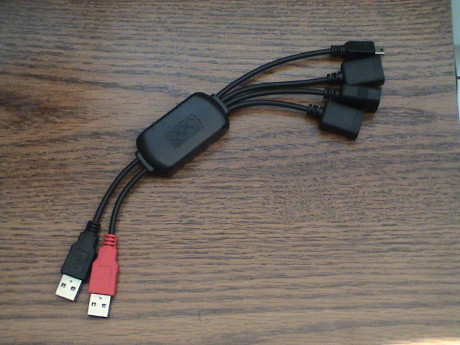 I saw strange
looking USB hub on the web and bought one for $12 at usb.brando.com.hk. The part number is
UHUBS004000. It would have been perfect had it worked properly but so
far, it has not.
I saw strange
looking USB hub on the web and bought one for $12 at usb.brando.com.hk. The part number is
UHUBS004000. It would have been perfect had it worked properly but so
far, it has not.
It is a travel hub that uses two USB ports for power. It does not use a power adaptor. The red connector is the power only input, the black one on the same side is the combination data/power connector. There are 4 outputs, 3 standard USB jacks and one mini-connector that plugs right into one of the external disk drives.
The first one that I got worked as expected for a couple of hours and then failed. It refused to do anything at that point. I emailed the company that shipped it and they send another one without charge. This one didn't fail, but it didn't work with the PowerBook either. The drive would not spin up reliably. It would appear that the current limiting on the USB ports is just at the level that the drives needs and if the drive draws just a little too much current, the hub shuts down to protect itself. However, it is interesting that it DOES work properly with the iBook.
After some email conversations with the manufacturer, they agree that it isn't doing what it was intended to do and that they have a problem which they are "working" on. If they manage to fix it, this would be the solution to my problem. It is small and light and could power the external USB drive and also allow connection of a mouse, jump drive and PDA sync/charger cable all at the same time. Since there is no power adaptor, it won't be sensitive to power transients.
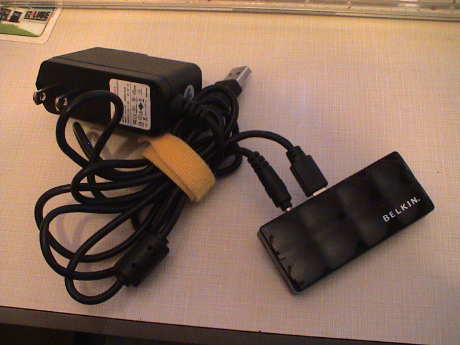 I found this Belkin USB hub (p/n FSU404-BLK) at Fry's for about $20. This one has a 2 amp 110/240 VAC charger and will power at least three external USB drives at the same time. On yet a different cruise ship (Holland America MS Veendam) with a different electrical system, the computer would still wake up from sleep on occasion when the lights were turned on or off, but at least it woke gracefully.
I found this Belkin USB hub (p/n FSU404-BLK) at Fry's for about $20. This one has a 2 amp 110/240 VAC charger and will power at least three external USB drives at the same time. On yet a different cruise ship (Holland America MS Veendam) with a different electrical system, the computer would still wake up from sleep on occasion when the lights were turned on or off, but at least it woke gracefully.
[ Previous Tip ] [ Mac Tips ] [ Next Tip ]
This page has been accessed times since 1 May 2005
© 2005-2012 George Schreyer
Created 1 May 2005
Last Updated February 7, 2012